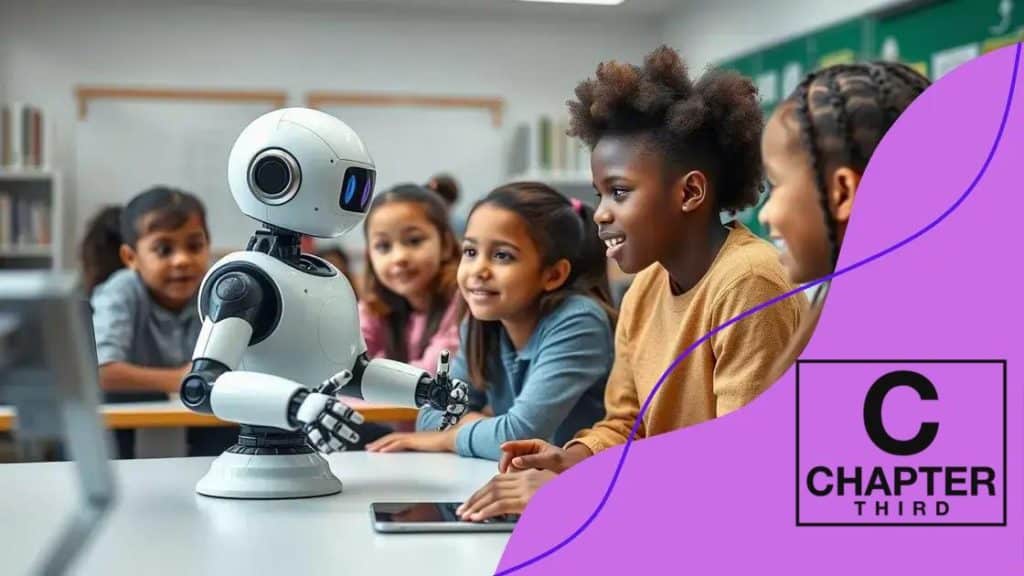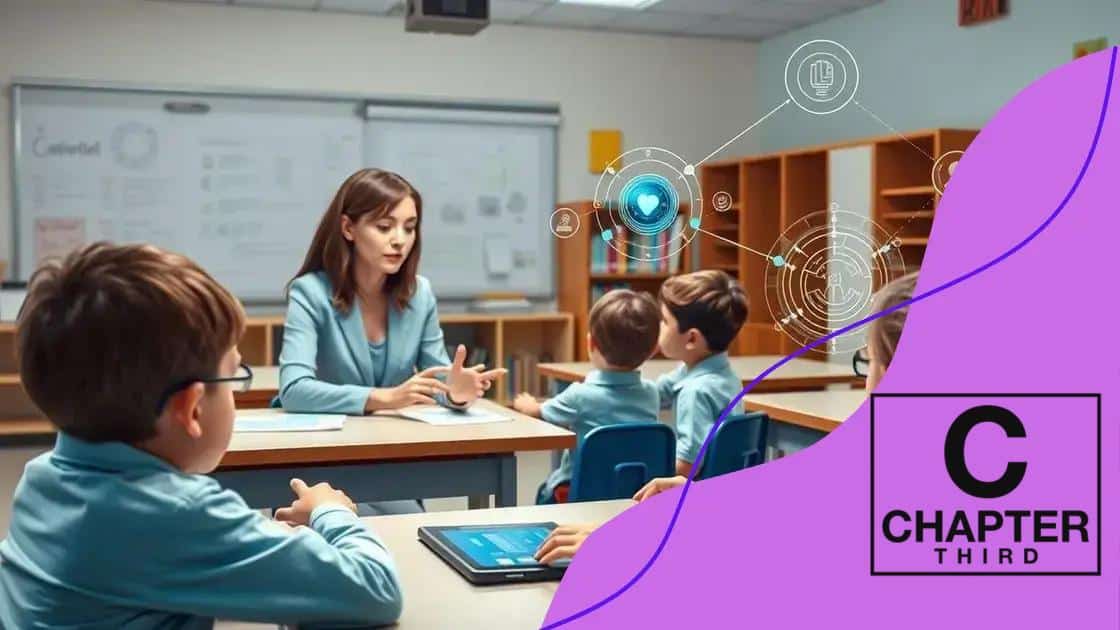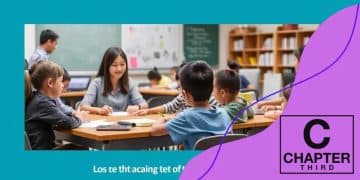ChatGPT-style tutors entering classrooms: a new wave in education

ChatGPT-style tutors entering classrooms enhance personalized learning by adapting to individual student needs, improving engagement, and providing real-time feedback, ultimately transforming educational experiences.
ChatGPT-style tutors entering classrooms might just be what education needs to adapt to modern learning demands. Have you ever wondered how AI could personalize education and enhance student engagement? Let’s dive into this exciting transformation.
The rise of AI tutors in education
The rise of AI tutors in education marks a significant change in how we approach learning today. These digital assistants are designed to personalize the learning experience for students, offering a range of support that traditional methods cannot match.
One major advantage of AI tutors is their ability to adapt to individual learning styles. For instance, a student struggling with math concepts can receive tailored exercises that target their specific weaknesses. Moreover, the immediate feedback provided by these tutors can help reinforce learning in real-time.
Benefits of AI Tutors
Implementing AI technology in classrooms can bring numerous benefits, including:
- Personalized learning paths for each student
- Instant feedback on assignments and quizzes
- Accessibility for students with different learning needs
Continuous advancements in technology enhance the capabilities of these tutors. They are equipped to analyze student performance and adjust their teaching methods accordingly, which can lead to improved outcomes. This adaptability ensures that lessons stay engaging and relevant, drawing students deeper into the material.
Challenges in Implementation
While the potential of AI tutors is vast, there are challenges to consider. Integration with existing curricula can be complex, requiring training for teachers and adjustments to teaching styles. Additionally, concerns about data privacy and the role of human educators in the learning process need to be carefully addressed.
Despite these challenges, the future looks promising. As AI continues to evolve, so too will its applications in the classroom. Schools that embrace these technologies are likely to see transformations in student engagement and achievement.
Benefits of ChatGPT-style tutoring
The benefits of ChatGPT-style tutoring are vast and impactful, offering innovative solutions to traditional education challenges. These AI-powered tutors provide personalized learning experiences that cater to the unique needs of each student.
One major advantage is the ability to deliver customized content. For example, a student struggling with reading comprehension can engage in targeted exercises designed specifically to enhance their skills. This kind of tailored approach not only boosts confidence but also encourages deeper understanding.
Immediate Feedback
Another key benefit is the system’s capacity for immediate feedback. With traditional tutoring methods, there can be delays in responses. However, AI tutors provide instant corrections and suggestions that help students learn from their mistakes on the spot.
- Increased retention of information
- Enhanced engagement through interactive learning
- Motivation to practice more frequently
Moreover, ChatGPT-style tutors can operate 24/7, allowing students to learn at their own pace and on their own schedule. This flexibility is particularly beneficial for those with busy lives, as they can access help whenever they need it.
Accessibility and Inclusivity
These AI tutors also promote accessibility in education. Students from different backgrounds or those with learning disabilities can gain support tailored to their specific challenges. This inclusive approach ensures that everyone has the opportunity to succeed.
As educational environments evolve, integrating ChatGPT-style tutoring can enhance the overall learning experience, bridging knowledge gaps and making education more engaging and effective for all students.
Challenges and considerations in implementation

Implementing ChatGPT-style tutoring in educational settings presents a variety of challenges and considerations that need careful attention. Understanding these factors is crucial for a successful integration into classrooms.
One of the primary challenges is the need for proper teacher training. Educators must feel comfortable using AI tools and understand how to integrate them into their teaching methods. Without adequate training, the potential of AI tutors may not be fully realized.
Technology Infrastructure
Another consideration is the technology infrastructure required to support AI tutoring. Schools need reliable internet access and adequate hardware to ensure that students can utilize these tools effectively. In some areas, especially rural or underprivileged communities, this can pose a significant barrier.
- Need for investment in technology
- Ensuring all students have access
- Regular maintenance and updates of systems
The issue of data privacy also weighs heavily on the implementation of AI in classrooms. Schools must navigate the regulations surrounding student data, ensuring that any information collected by AI systems is secured and used ethically. This requires clear guidelines and policies.
Balancing AI with Human Interaction
Furthermore, there is the challenge of finding the right balance between AI support and human interaction in the learning process. While AI can provide personalized feedback and support, the role of teachers remains vital for developing social skills and emotional connections in students. It’s important to remember that technology should enhance, not replace, the human touch in education.
Overall, addressing these challenges will be essential for effectively implementing ChatGPT-style tutoring. Schools need to take a comprehensive approach to ensure that all elements work together to create a beneficial learning environment.
Real-life success stories of AI tutors
Real-life success stories of AI tutors demonstrate their profound impact on education, showcasing how this technology improves learning outcomes for students across various settings. These stories reveal the practical benefits of using AI in classrooms and provide inspiration for others.
One compelling example comes from a school district that integrated AI tutoring to assist students struggling in mathematics. By using a ChatGPT-style tutor, students received personalized assistance tailored to their specific needs. As a result, the school saw a significant increase in math scores, with many students expressing newfound confidence in their abilities.
Improved Engagement
Another success story involves a high school that implemented AI tutoring tools for its English language learners. The AI provided real-time feedback on language use and comprehension, which helped students improve their communication skills faster than traditional methods. Many students reported feeling more engaged and motivated during their language classes.
- Enhanced interactive learning experiences
- Increased participation in discussions
- Stronger peer-to-peer collaboration
Additionally, a nonprofit organization used AI tutors to assist students in underserved communities. By offering free access to these tools, they were able to bridge educational gaps and provide resources where they are most needed. Reports showed improvements in literacy rates among the students who utilized the AI tutors regularly.
Customized Learning Paths
A university also embraced AI tutoring to create customized learning paths for its students. With advanced analytics, the AI monitored student progress and adapted content accordingly. This personalization led to higher graduation rates, as students found it easier to stay on track and grasp complex concepts.
These real-life examples illustrate the versatility and effectiveness of AI tutors, highlighting how they can transform educational experiences. As more success stories emerge, it becomes increasingly clear that integrating AI into education can lead to remarkable advancements for students.
Future trends in educational technology
Looking ahead, the future trends in educational technology promise exciting advancements that can reshape how students learn. Emerging technologies continue to evolve, combining traditional teaching methods with innovative tools.
One of the most significant trends is the rise of artificial intelligence in the classroom. AI-driven platforms will offer increasingly personalized learning experiences, adapting to individual student needs much like ChatGPT-style tutors do today. This means that lessons can be tailored in real-time to match student performance.
Hybrid Learning Environments
Another trend is the growth of hybrid learning environments. Schools are blending online education with in-person instruction more than ever. This flexible approach allows students to benefit from both worlds, providing greater accessibility and convenience.
- More opportunities for remote learning
- Enhanced collaboration through digital tools
- Increased engagement with interactive content
Furthermore, as technology becomes more embedded in education, gamification will grow in popularity. Integrating game-like elements into lessons can motivate students and foster a love for learning. Teachers can create engaging activities that reward progress and encourage friendly competition among classmates.
Virtual and Augmented Reality
Another exciting area to watch is the use of virtual and augmented reality. These technologies can provide immersive learning experiences that traditional methods cannot. Imagine students exploring the solar system or ancient civilizations without leaving the classroom. Such experiences can enhance understanding and retention.
As we anticipate these trends, it becomes evident that technology will continue to play a vital role in education. By embracing new tools and methodologies, educators can offer students richer and more engaging learning experiences.
FAQ – Frequently Asked Questions about AI Tutors in Education
What are ChatGPT-style tutors?
ChatGPT-style tutors are AI-driven educational tools that provide personalized assistance to students, adapting to their learning needs.
How can AI tutoring improve student engagement?
AI tutoring offers interactive and customized learning experiences, which can motivate students and keep them more involved in their studies.
What challenges come with implementing AI tutors in schools?
Challenges include the need for teacher training, ensuring technology infrastructure is in place, and addressing data privacy concerns.
What are some examples of success with AI tutors?
Success stories include improved test scores, increased engagement among students, and enhanced support for learners in underserved communities.





